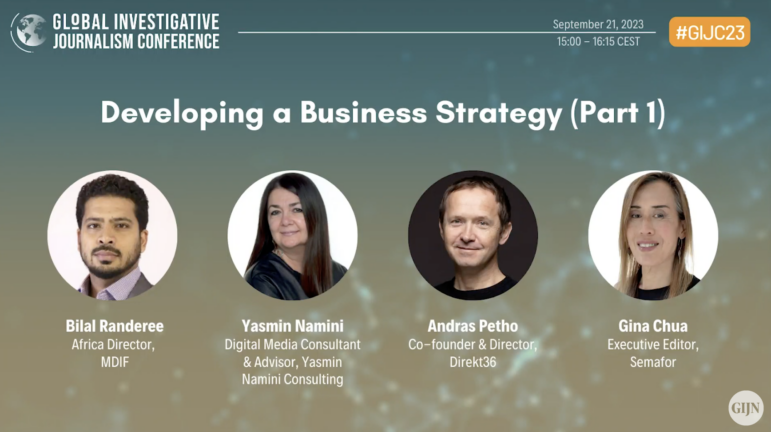

Image: Shutterstock
How Independent Journalism Is Filling Gaps in the European Media Landscape
This post is an excerpt from “The New Sector,” a May 2022 report on the state of independent public interest journalism in Europe, by Netzwerk Recherche, Germany’s association of investigative journalists. It is reprinted here with permission. Other groups that participated in this project include Arena for Journalism in Europe, the research institutes ZeMKI at Bremen University, and the Leibniz-Institut für Medienforschung (Hans-Bredow-Institut) in Hamburg. The New Sector report was funded by the Schöpflin Foundation.
When Swiss journalist Christian Zeier and his small team launched REFLEKT in 2019, the first nonprofit investigative newsroom in the country came to life. In times when publishing houses merge publications, impose budget cuts, and announce layoffs to squeeze profits out of the declining business as long as possible, REFLEKT’s idea was both simple and daunting: to conduct the kind of time-consuming investigations other outlets simply weren’t capable or willing to focus on anymore. Three years later, the pioneers of REFLEKT have won awards for their work and created a role model for like-minded journalistic entrepreneurs in Switzerland and beyond.
With legacy media still reeling from the crisis of its own business model, journalistic pioneers, like REFLEKT, are not simply trying to fix a broken system but create a new, value-centered, less profit-oriented one instead.
While the US is further along in establishing not-for-profit journalism as an alternative to legacy media, both it and the European media landscapes are too complex to be reduced to nonprofits alone. Legal preconditions to gain charitable status differ from country to country, which has led to an uneven distribution of officially registered nonprofits across the continent. Still, the undeniable rise of independent news organizations calls for the creation of a comparable supporting infrastructure to the ones seen in the US (e.g. Institute for Nonprofit News (INN), NewsMatch, etc.).
In order to build such a support system, it’s crucial for all stakeholders to gain an analytical overview of the sector to see who is already there, what is lacking at this stage, and which challenges lie ahead. This is why Netzwerk Recherche (NR), the German association of investigative journalists, has, for the first time, mapped Europe’s emerging innovative media scene and examined how it is reclaiming journalistic terrain largely neglected by traditional media in the past.
What defines members of this New Sector isn’t their tax status but a “nonprofit state of mind” — an approach based on the idea of serving an audience, a community, and democracy as a whole through public interest journalism. Profit is not their number one priority. Instead, they provide much-needed coverage for a local, national, or European audience, enabling informed citizens to make good decisions.
Inspired by the work of INN, NR provides an interactive map and insights into the sector’s funding, as well as its societal value based on 80 responses to an online survey. Participants are based in 26 European countries. Though there is a certain geographic imbalance in data due to a disproportionately large share of participants from Germany (29 responses), the collected information still enables site visitors to draw conclusions about trends and shared obstacles within the sector.

Netzwerk Recherche has mapped the rise of independent public journalism sites across Europe, a slight majority of which follow a nonprofit business model. Image: Courtesy of Netzwerk Recherche, map via Datawrapper
Size and Growth
The New Sector mainly consists of small to mid-sized newsrooms with up to 20 employees. Only a few outlets rely on voluntary work (6.3%). The rest have at least some people on the payroll. One third have less than five, full-time paid workers. The most common newsroom size was five to 10 full-time employees (25%). Fewer organizations (17.5%) have grown to the point where they employ more than 20 people.
These rather small teams are no surprise, since most of these outlets are relatively new to the market. In fact, there has been a sharp increase in newly founded outlets in the last decade, with a noticeable drop in news site launches in the past two recent years because of the pandemic.
Charitable Status and Revenue
Notably, a slight majority of those who participated in the survey are legally registered nonprofit newsrooms. Again, these numbers might exaggerate the real share of nonprofits among the independent public interest media landscape in Europe. Still, the data shows an interesting and encouraging development: despite all the hustle and hurdles blocking the path to charitable status, quite a lot of outlets have pursued this model. Their decision to seek charitable status falls in line with the media economy’s desperate search for new, sustainable business models. With ad money and subscription revenue declining, The New Sector explores new funding opportunities like foundation support, which often requires charitable status. That was one reason Swiss journalist Christian Zeier and his team built REFLEKT as a nonprofit.
“We chose a nonprofit model for three reasons,” Zeier explained. “First, it shows our readers and supporters that we invest all our funds into journalism. Second, it’s easier for certain donors — such as foundations — to support a nonprofit organization. And third, the recognition of nonprofit status by local authorities exempts us from paying taxes.”

Two-thirds of the New Sector media sites surveyed generate financial support from foundations. Image: Netzwerk Recherche
Like many other small newsrooms, REFLEKT relies heavily on foundation funding. And the strong philanthropic scene of wealthy Switzerland is the perfect environment for such a project to thrive. Despite their comfortable situation, Zeier and his team are trying to end their dependence on just a few major donors.
“The conditions in Switzerland are certainly an advantage for such a model. We’ve heard from colleagues in other countries that they could never rely on foundations to such an extent,” Zeier noted. “However, our business plan foresees an annual decrease in foundation funding. In the long term, we want to diversify our funding and make it more sustainable. Therefore, we are currently intensifying our efforts to convince patrons and members of the importance of our project.”
Experts have long praised the advantages of diversified revenue streams, and research shows Europe’s public interest newsrooms rely upon a broad range of income-generating mechanisms. Much of The New Sector is supported by a mix of income flows, with individual donations being the number one source of revenue. Far ahead of all the other sources of income, foundational support is the second largest contributor. Compared to similar research of funding models for independent media in the US and Canada, advertising plays a smaller part in supporting European public interest media.
Even though most newsrooms have diversified their business model, financial stability remains the sector’s biggest concern. Since this is a common challenge facing almost all journalism start-ups, a group of 20-plus media organizations from within the sector recently joined forces to create the knowledge sharing network Reference. The idea of the group is to spark exchange of experiences and learn from peers — so as not to repeat mistakes others have already made.
“Reference is unique because it enables cooperation and knowledge transfer at an organizational, and not editorial, level,” Zeier said. “Therefore, we hope to learn from similar projects with similar challenges and are happy to share our own experiences with colleagues all over Europe.”
Guardians of Democracy
The fate of the pioneering outlets in The New Sector should interest more than just those directly involved. What makes the sphere of public interest journalism so important for society is that it tries to tackle one of the biggest crises confronting modern democracies: the erosion of trust in public institutions. The global rise of populism and the lack of an adequate response by politicians and media alike are among the many causes of this problem. Diminishing media diversity and the emergence of news deserts also contribute to the issue.
The New Sector is trying to fill these gaps.
Where legacy media have pulled out of local coverage, these outlets jump in. Roughly one third in the sample is covering local or even hyper-local issues. Half the outlets surveyed offer regional coverage. Roughly the same amount investigates European cross-border topics.

New Sector journalism sites cover a number of critical subject areas, with an emphasis on holding power to account. Image: Netzwerk Recherche
Their self-selected role as servants of a democratic society also becomes apparent as the sector shows heavy engagement in watchdog journalism. Nearly three out of four — 70% — of the surveyed newsrooms mention investigative journalism as one field of expertise, an impressive share given the fact that economic challenges have led to a slow and silent decrease of investigative journalism in many media companies (top-notch newsrooms excluded).
Sharing is Caring
New independent public interest newsrooms are a driving force in transforming the European media landscape. They share the intrinsic motivation to provide public service journalism, which is essential for democratic societies, without sacrificing that pursuit to ensure profits.
Still, challenges lie ahead. First and foremost: financial sustainability. Large nonprofit foundations alone cannot make up for the failing business model of a whole industry, but their financial support is one of the cornerstones of the rise of The New Sector, since it enables journalistic entrepreneurs to start their own project from scratch. To improve the chances for these startups to become sustainable in the long-run, many challenges must be addressed. Legal obstacles like the lack of a tax-exempt nonprofit structure for journalism outlets still hinder the sector in many countries. Additionally, audience-centered business models haven’t reached their full potential yet.
REFLEKT’s Christian Zeier remains hopeful. Asked about his key takeaway from The New Sector research, Zeier says: “The most important finding is that we’re not alone with our vision and that it can and does work in different contexts. Additionally, it’s a very helpful starting point to find like-minded organizations and share best practices.”
In Switzerland, REFLEKT is no longer the only nonprofit investigative newsroom. Since it launched in 2019, other independent newsrooms like WAV and Hauptstadt (in English, “Capital”) have entered the stage. That REFLEKT and WAV joined forces for investigations and Zeier, with his expertise as founder, got personally involved in pushing the start of Hauptstadt displays the unique strength of this group of journalists: a shared vision focusing on societal impact rather than profit.
Additional Resources
Survival Tips for Nonprofit Newsrooms: Fundraising, Membership, and Sustainable Models
New Models: How Academics, Nonprofit News and Government are Collaborating
GIJN Resource Center: Sustainability
 Malte Werner is a German journalist and project manager at Netzwerk Recherche. His work has been featured in the Guardian, Al Jazeera, Die Zeit, GEO, taz, and other publications.
Malte Werner is a German journalist and project manager at Netzwerk Recherche. His work has been featured in the Guardian, Al Jazeera, Die Zeit, GEO, taz, and other publications.










